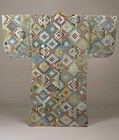Japanese Gallery (Honkan) Room 9
August 21, 2007 (Tue) - October 21, 2007 (Sun)
Yamanba (mountain hag) generally depicts an ugly woman with long, unkempt, white hair with surreal power like a witch. In the Noh play "Yamanba", however, the woman is more affable; she provided lodging for a traveling group and displayed both humanistic and artistic aspects.
Background story:
There was a courtesan in Kyoto nicknamed Hyakuma-yamanba, who was known for her kusemai dance, which based on the life of the demon Yamanba. The actor playing Hyakuma-yamanba donned a ko-omote mask and a karaori garment with red threads. As Hyakuma-yamanba traveled with her attendants on their way to Zenkoji temple, the sky suddenly became dark. Disoriented, they were approached by the demon Yamanba, who is dressed in a karaori garment devoid of red and wearing a mask of a middle-aged woman, who appeared out of nowhere. The party accepted Yamanba's gracious offer of lodging; afterwards, she informed them that she was Yamanba.
Yamanba said she had heard about the courtesan Hyakuma-yamanba who performs a famous dance based on her life. She explained that caused the sky to become dark because she wanted Hyakuma-yamanba to stay and show her the dance. After that, she disappeared. Yamanba reappeared later that night, wearing a red mask with pure white hair and glittering eyes, an atsuita garment tucked up to the waist, and gold brocade trousers.
Complying with Yamanba's request, Hyakuma-yamanba sang and Yamanba danced. Elated, Yamanba projected images of living among the mountains during the four seasons. After she finished, she rushed up the mountain ridge, jumped over the valley, and disappeared beyond the mountains.
Yamanba said she had heard about the courtesan Hyakuma-yamanba who performs a famous dance based on her life. She explained that caused the sky to become dark because she wanted Hyakuma-yamanba to stay and show her the dance. After that, she disappeared. Yamanba reappeared later that night, wearing a red mask with pure white hair and glittering eyes, an atsuita garment tucked up to the waist, and gold brocade trousers.
Complying with Yamanba's request, Hyakuma-yamanba sang and Yamanba danced. Elated, Yamanba projected images of living among the mountains during the four seasons. After she finished, she rushed up the mountain ridge, jumped over the valley, and disappeared beyond the mountains.

